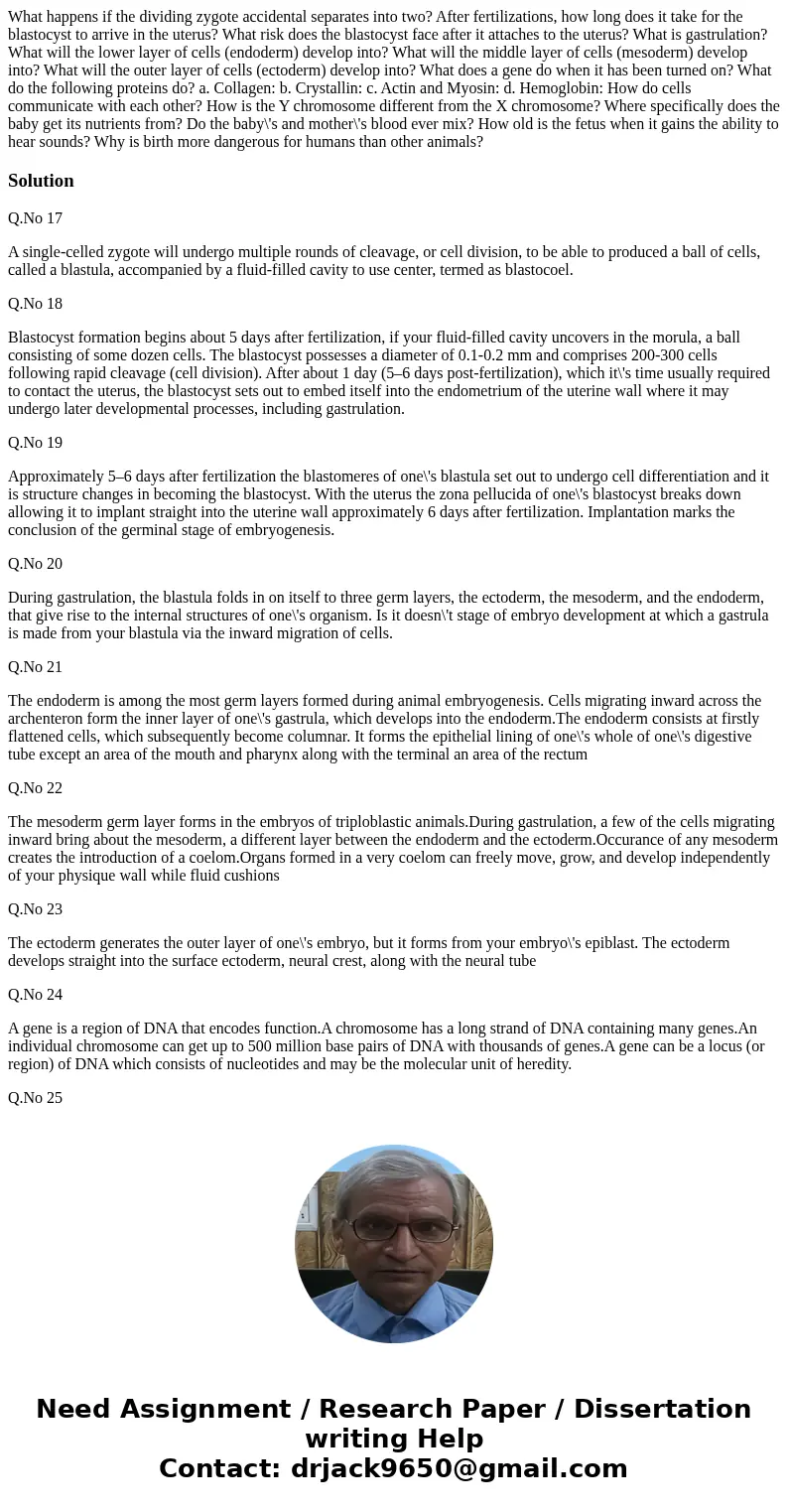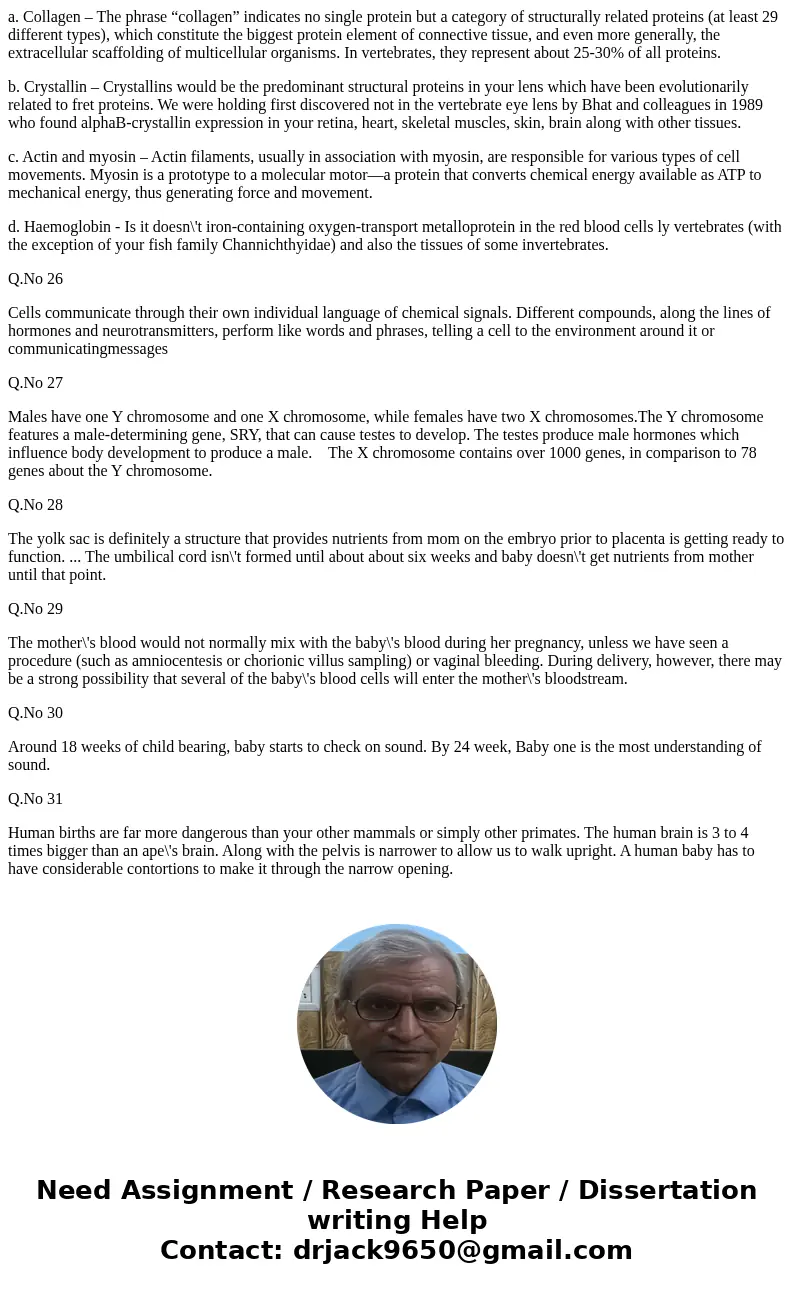What happens if the dividing zygote accidental separates int
Solution
Q.No 17
A single-celled zygote will undergo multiple rounds of cleavage, or cell division, to be able to produced a ball of cells, called a blastula, accompanied by a fluid-filled cavity to use center, termed as blastocoel.
Q.No 18
Blastocyst formation begins about 5 days after fertilization, if your fluid-filled cavity uncovers in the morula, a ball consisting of some dozen cells. The blastocyst possesses a diameter of 0.1-0.2 mm and comprises 200-300 cells following rapid cleavage (cell division). After about 1 day (5–6 days post-fertilization), which it\'s time usually required to contact the uterus, the blastocyst sets out to embed itself into the endometrium of the uterine wall where it may undergo later developmental processes, including gastrulation.
Q.No 19
Approximately 5–6 days after fertilization the blastomeres of one\'s blastula set out to undergo cell differentiation and it is structure changes in becoming the blastocyst. With the uterus the zona pellucida of one\'s blastocyst breaks down allowing it to implant straight into the uterine wall approximately 6 days after fertilization. Implantation marks the conclusion of the germinal stage of embryogenesis.
Q.No 20
During gastrulation, the blastula folds in on itself to three germ layers, the ectoderm, the mesoderm, and the endoderm, that give rise to the internal structures of one\'s organism. Is it doesn\'t stage of embryo development at which a gastrula is made from your blastula via the inward migration of cells.
Q.No 21
The endoderm is among the most germ layers formed during animal embryogenesis. Cells migrating inward across the archenteron form the inner layer of one\'s gastrula, which develops into the endoderm.The endoderm consists at firstly flattened cells, which subsequently become columnar. It forms the epithelial lining of one\'s whole of one\'s digestive tube except an area of the mouth and pharynx along with the terminal an area of the rectum
Q.No 22
The mesoderm germ layer forms in the embryos of triploblastic animals.During gastrulation, a few of the cells migrating inward bring about the mesoderm, a different layer between the endoderm and the ectoderm.Occurance of any mesoderm creates the introduction of a coelom.Organs formed in a very coelom can freely move, grow, and develop independently of your physique wall while fluid cushions
Q.No 23
The ectoderm generates the outer layer of one\'s embryo, but it forms from your embryo\'s epiblast. The ectoderm develops straight into the surface ectoderm, neural crest, along with the neural tube
Q.No 24
A gene is a region of DNA that encodes function.A chromosome has a long strand of DNA containing many genes.An individual chromosome can get up to 500 million base pairs of DNA with thousands of genes.A gene can be a locus (or region) of DNA which consists of nucleotides and may be the molecular unit of heredity.
Q.No 25
a. Collagen – The phrase “collagen” indicates no single protein but a category of structurally related proteins (at least 29 different types), which constitute the biggest protein element of connective tissue, and even more generally, the extracellular scaffolding of multicellular organisms. In vertebrates, they represent about 25-30% of all proteins.
b. Crystallin – Crystallins would be the predominant structural proteins in your lens which have been evolutionarily related to fret proteins. We were holding first discovered not in the vertebrate eye lens by Bhat and colleagues in 1989 who found alphaB-crystallin expression in your retina, heart, skeletal muscles, skin, brain along with other tissues.
c. Actin and myosin – Actin filaments, usually in association with myosin, are responsible for various types of cell movements. Myosin is a prototype to a molecular motor—a protein that converts chemical energy available as ATP to mechanical energy, thus generating force and movement.
d. Haemoglobin - Is it doesn\'t iron-containing oxygen-transport metalloprotein in the red blood cells ly vertebrates (with the exception of your fish family Channichthyidae) and also the tissues of some invertebrates.
Q.No 26
Cells communicate through their own individual language of chemical signals. Different compounds, along the lines of hormones and neurotransmitters, perform like words and phrases, telling a cell to the environment around it or communicatingmessages
Q.No 27
Males have one Y chromosome and one X chromosome, while females have two X chromosomes.The Y chromosome features a male-determining gene, SRY, that can cause testes to develop. The testes produce male hormones which influence body development to produce a male. The X chromosome contains over 1000 genes, in comparison to 78 genes about the Y chromosome.
Q.No 28
The yolk sac is definitely a structure that provides nutrients from mom on the embryo prior to placenta is getting ready to function. ... The umbilical cord isn\'t formed until about about six weeks and baby doesn\'t get nutrients from mother until that point.
Q.No 29
The mother\'s blood would not normally mix with the baby\'s blood during her pregnancy, unless we have seen a procedure (such as amniocentesis or chorionic villus sampling) or vaginal bleeding. During delivery, however, there may be a strong possibility that several of the baby\'s blood cells will enter the mother\'s bloodstream.
Q.No 30
Around 18 weeks of child bearing, baby starts to check on sound. By 24 week, Baby one is the most understanding of sound.
Q.No 31
Human births are far more dangerous than your other mammals or simply other primates. The human brain is 3 to 4 times bigger than an ape\'s brain. Along with the pelvis is narrower to allow us to walk upright. A human baby has to have considerable contortions to make it through the narrow opening.


 Homework Sourse
Homework Sourse